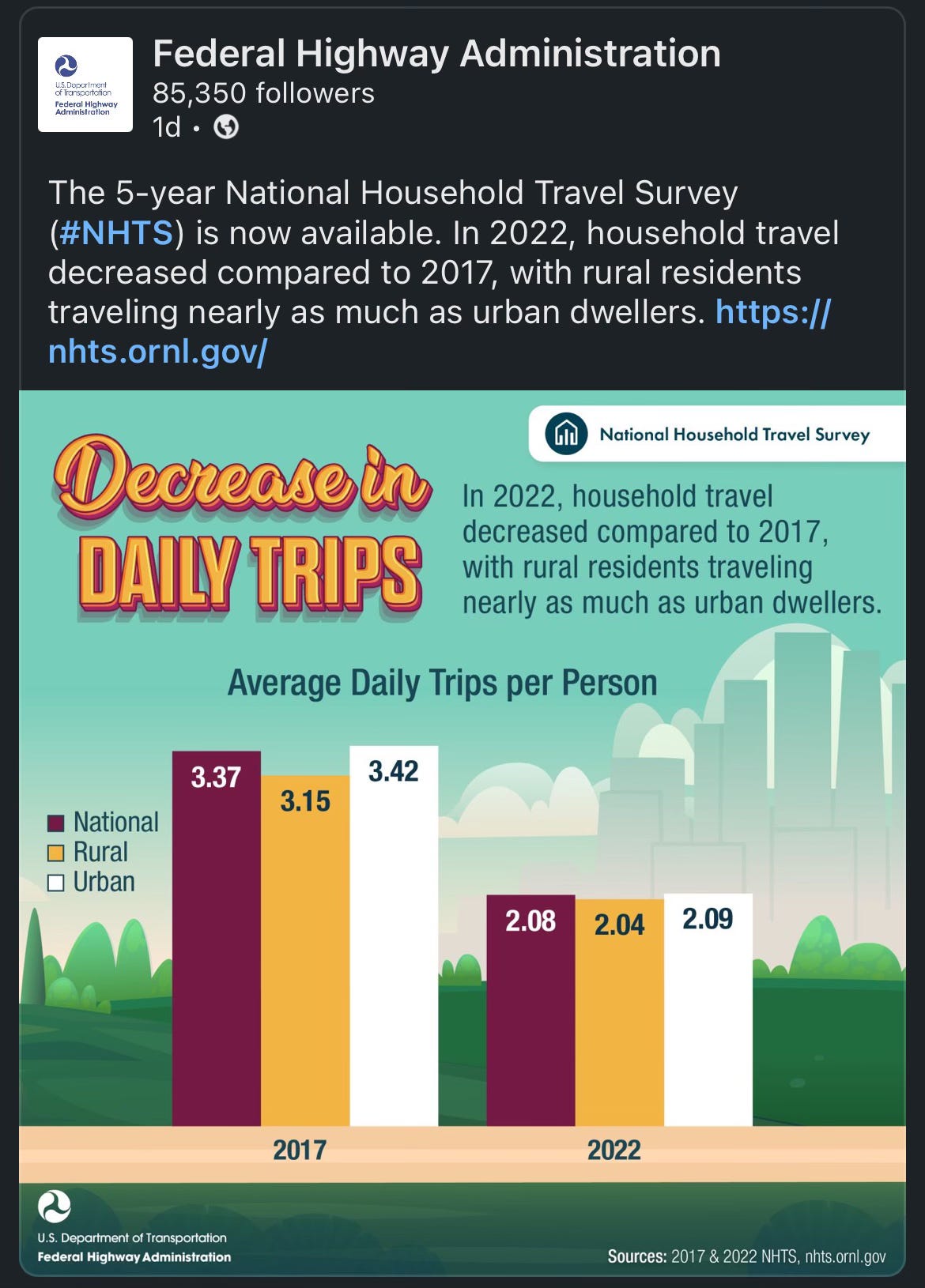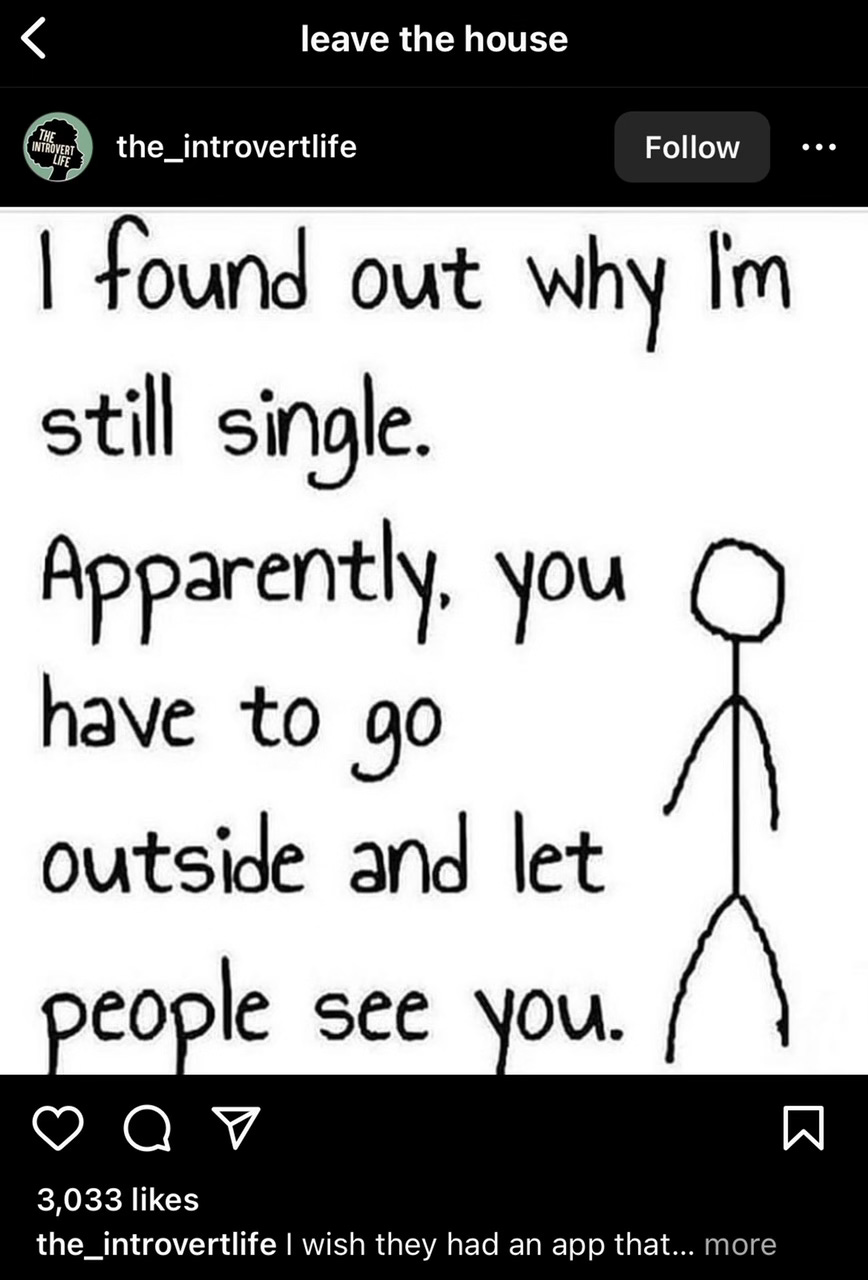Nobody's leaving the house anymore
The ground has shifted in the last few years in ways we're still trying to understand
I came across this chart this week that I thought was pretty stunning.
I don’t think a lot of people really get what this means so let me explain. According to new data, the National Household Travel Survey, which is one of the best data sources we have on how people get around in this country (but isn’t perfect), people are just leaving the house a lot less than they used to even a few years ago.
In 2017, Americans used to average more than three trips a day. Going to work and back and then going somewhere else — that’s three trips. And also maybe they went to the store every other day, or a friend’s house.
Now, people are taking just a little over 2 trips a day. AND as they point out, urban dwellers, who used to go more places than rural dwellers (which makes sense) now don’t really to an appreciable degree.
As I said, I find this stunning. And let me explain a little more why. This is a HUGE HUGE change in the way people live their lives and their daily activity. I have been involved in sustainable transportation advocacy for over a decade, and the kinds of changes we try to implement — I cannot imagine it having an impact on this scale this quickly.
The pandemic changed a lot of things about our society very quickly. This is a reminder that it has impacted people’s lives and continues to do so in very profound ways.
I was talking with some folks recently about a “transportation of the future” event and I was thinking in my head “I’m still sorta trying to get a handle on what’s going on in the present.”
On the new data: Right off the bat I want to say, this isn’t necessarily ALL bad. Advances in telecommunications mean we don’t have to leave the house as much for little errands. For example — recently I went to the bank (I’m not going to explain why because it’s boring but I do want to note that it’s possible I could have handled the business online but I wasn’t sure and the bank isn’t that far from my house.)
The bank was sorta busy and I ended up having to wait in line a little bit. And I started to get a little irrationally angry about it (I’m sort of embarrassed to admit.) And then I started to think about it and I was thinking, it’s rare sort of that I’m asked to physically wait in line in person for something any more. So much of these kinds of interactions have been automated and happen almost instantly over a computer now. I think my patience for it — after operating in this online environment where things happen so quickly — was just thin.
This is a little bit of an aside, but bear with me because I think it’s relevant/important. But I was wondering if this helps explain why we see such awful behavior on our roads right now. Those little polite interactions — with the bank teller or the person in front of you online — and knowing how to behave in them, that’s sort of an important element of society. Maybe, many people are just not having to practice those kinds of skills as much. Driving, I have always felt, feels a little like waiting in line. It’s kind of competitive. Feeling delayed, even for a few moments, feels insulting, in a way maybe it didn’t in the past. (Okay mini rant over.)
Obviously more people are working from home and that has a huge influence on people’s day-to-day lives and trip making. There are clearly a lot of benefits in that arrangement for workers — otherwise they wouldn’t be defending them so fiercely. I don’t even want to wade too much into that debate because it’s sorta boring (things can be complicated! They can be good and bad!).
BUT even taking into account working from home, I’m still surprised to see overall trip making declined so much.
Most trips by Americans (87%) are made in cars. BUT there’s also (alarming!) evidence that people are walking a lot less than they did just a few years ago (which was sort of a pathetic baseline in terms of walking). A analysis by Streetlight Data, which pulls location data from people’s cell phones, found walking declined 36% since the pandemic.
That is, frankly, a mind boggling reduction. It’s also all-the-more concerning, given that pedestrian deaths increased pretty dramatically over that period (about 20%). So not only, according to this data, are Americans walking WAY, WAY less than they used to a few years ago (which was already not very much), when they do they’re also WAY, WAY more likely to get hit by a car.
No bueno, my friends. I don’t see much a silver lining in this data on walking specifically.
This overall decline in trip making also troubles me, if I’m being honest. It used to be, trip making was sorta — not perfect but still — an indicator of quality of life. Rich people would take more trips than poor people, for eg. Certain people, people with disabilities, unemployed people, would make almost no trips and that was not a good thing, for them or for society. That is a little bit of a value judgement but truly not ideal for people’s mental or physical health to be more or less shut in.
This data indicates such a big change, I sorta don’t know what to make of it, and I’d be a little bit weary of anyone who pretends to have all the answers. One thing that concerns me, this growing pattern of isolation, which I’ve written about a little bit: Growing loneliness in our society.
I often see these memes on Instagram. And they are supposed to be relatable. And they are often about cancelling plans, or how great it is to not leave the house. I have to say I find these memes a little bit weird. I still think it’s kinda shitty to cancel plans on a friend at the last minute. And I still think its kinda uncool to sit around scrolling instead of going out and being active (sorry, not sorry!).
One of my thoughts about this, I think a lot of people are really struggling. I think some people who are hardly making any trips have depression that probably borders on clinical. It’s concerning. We talk about a mental health crisis for youth. I think we need to widen the frame a little bit. A lot of adults are struggling right now as well.
This is a lot of change to adapt to. And I think, as I said earlier, there are drawbacks and benefits for everyone. But I think we should keep an eye on some of these potential concerns. Check in on your friends. Try to rebuild a little bit of in person community in your neighborhood. And be careful out there if you're walking.






Great article - this is clearly the double-edged sword of our expanding technology. If I think of my grandparents or even my parents at the age I am now, they had to travel around and interact with so many people to do things. If they wanted clothes, they probably went to a store and talked to a sales person. If they needed a check deposited, they went to a bank. If they wanted a sandwich, they went to a deli and ordered from a person. If they wanted to see a movie, they went there and bought a ticket from a person. I can even think of more recent changes, where if I wanted to go a fast food place, I would order from someone. Now in some cases that is not even possible if you wanted to.
All of that can now be done sitting on your couch. And that is great - unfortunately so many of us are not trading those tasks that seem like deadweight for just mindless scrolling. And work from home (for the small portion of people who actually do these office jobs) is like the major force accelerator here. Again great to have it but we are almost committing a kind of self-inflicted solitary confinement.
I don't know how you get past this, other than trying to get out and do things yourself.
If people on average are taking just over two trips a day, it’s hard to truly correlate this to people working from home. Those two trips a day could very well be people coming and going to work. I think something that was missed in this article is that going out costs money and I personally think this has a lot more to do with our economy. People don’t have the extra money to go out these days but also many small businesses did not make it through the pandemic. Even if you wanted to go out and shop what you have are the exact same big businesses from town to town which for me personally makes going out less interesting and desirable. We have more delivery services so many people are not even taking trips to the grocery store. Movie theaters aren’t really showing new movies with new stories. And I do think evolving to a new way of life during the pandemic got folks comfy with taking the path of least resistance. Anxiety is very much on the rise. And I believe this is very linked to being more effected to unpleasant stimuli out in the world.